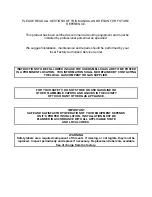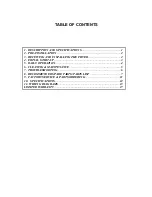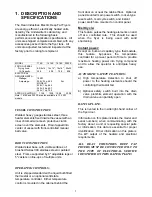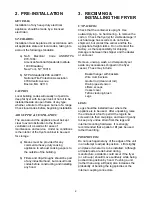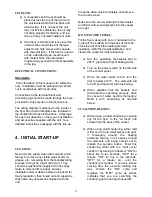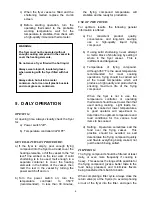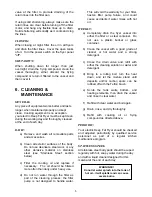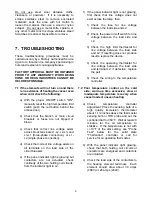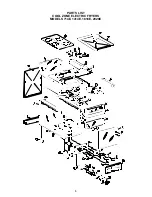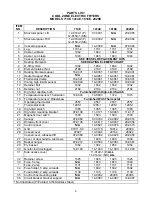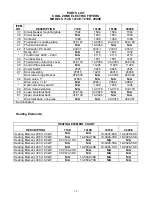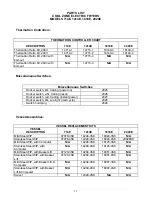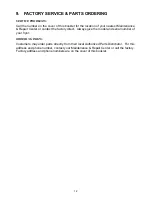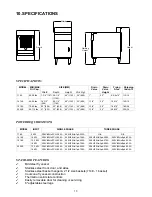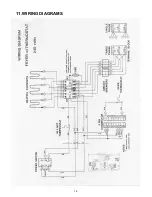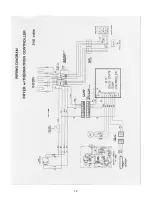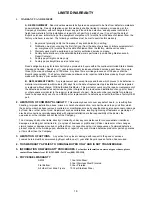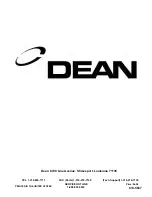
4
c) When the fryer vessel is filled and the
shortening melted, replace the crumb
screen.
d) Before starting operation, turn the
operating thermostat to the probable
working temperature, wait for the
temperature to stabilize, then check with
a high-quality immersion thermometer.
5. DAILY OPERATION
OPENING:
At opening time, always visually check the fryer
for:
a) Power switch "off".
b) Temperature controller dial "OFF".
GENERAL TURN-ON PROCEDURE:
a) If the fryer is empty, pour enough frying
compound into the fryer to at least cover the
heating elements, or fill the vessel to the "oil
level" line scribed on the rear wall. If solid
shortening is to be used, melt enough in a
separate container to cover the heating
elements in the bottom of the vessel, then
melt the rest in the vessel by turning the
power switch off and on.
b) Turn the power switch on; turn the
temperature controller to 350°F
(recommended). In less than 30 minutes,
the frying compound temperature will
stabilize and be ready for production.
USE OF THE FRYER:
For optimum results, the following general
information is offered.
a) For consistent product quality,
convenience, and long-term savings,
use a high-quality liquid frying
compound.
b) If using solid shortening, never attempt
to melt a block of shortening by setting it
whole in the fryer vessel. This is
inefficient and dangerous.
c) Temperature of frying compound.
Although 350°F is the usual temperature
recommended for most cooking
operations, frying should be carried out
at the lowest temperature which will
produce a high quality and product while
ensuring maximum life of the frying
compound.
When the fryer is not in use, the
temperature controller or operating
thermostat should be set lower than that
used during cooking. Light loads, too,
may be cooked at lower temperatures.
A good operator will experiment to
determine the optimum temperature and
load conditions for the various food
items to be cooked.
d) Salting. Operators sometimes salt the
food over the frying vessel. This
practice should be avoided, as salt
deteriorates the frying compound quickly
and flavors everything being cooked, not
just the batch being salted.
FILTERING:
The frying compound should be filtered at least
daily, or even more frequently if cooking is
heavy. This assures the longest life possible for
the frying compound, gives a better taste to the
food being prepared, and minimizes flavors
being transferred from batch to batch.
When completing a filter cycle, always close the
return valve(s) at the fryer(s) to avoid siphoning
oil out of the fryer into the filter, and open the
WARNING:
The fryer must not be operated without
enough cooking compound in the vessel to
cover the heating elements.
Do not move a fryer filled with a hot liquid.
Always wear oil-proof, insulated gloves
when working with the fryer filled with hot
oil
Always drain hot oil into a metal
container...hot oil can melt plastic buckets
and crack glass on containers.
Summary of Contents for 1414E
Page 11: ...8 PARTS LIST COOL ZONE ELECTRIC FRYERS MODELS 714E 1414E 1818E 2020E ...
Page 17: ...14 11 WIRING DIAGRAMS ...
Page 18: ...15 ...
Page 19: ...16 ...
Page 20: ...17 ...


